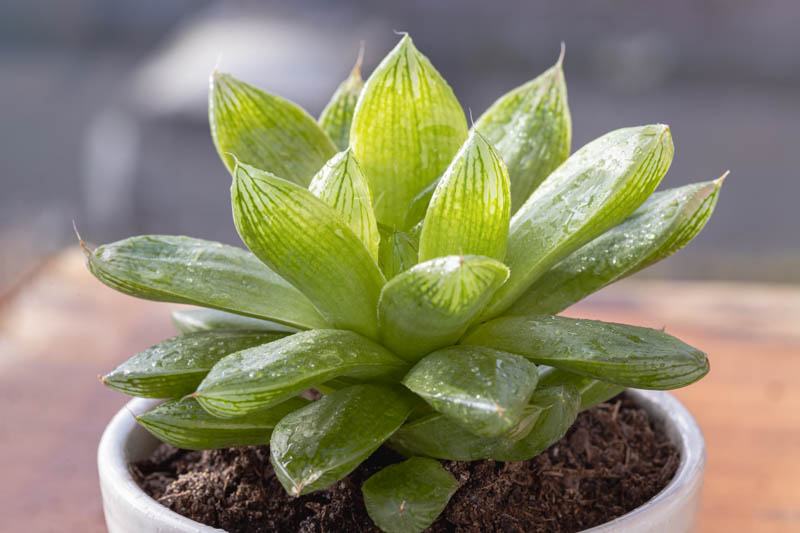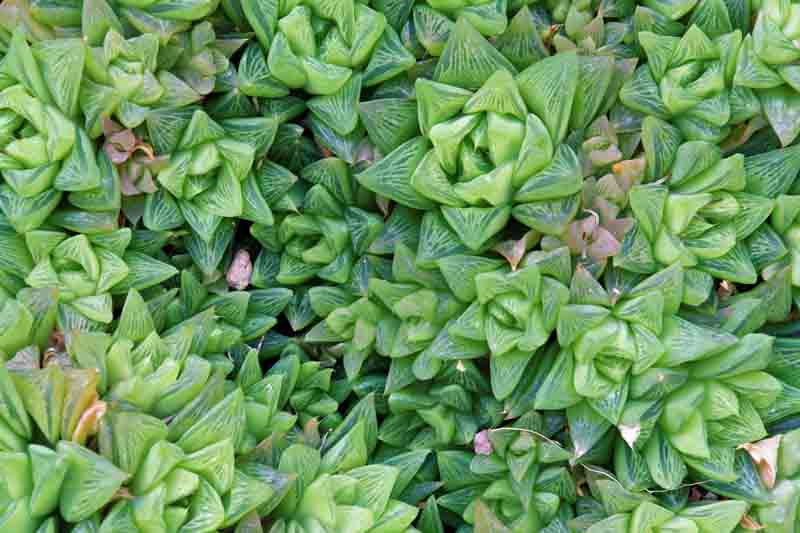Boat-formed Haworthia, Cathedral Window Haworthia, Windowed Boats, Window Boats, Window Haworthia
Haworthia cymbiformis, often admired for its distinctive, lush, and sculptural qualities, embodies the essence of both resilience and beauty. This succulent, a gem in the realm of houseplants, is not just an ornament but a specimen teeming with intriguing characteristics and uses.
Haworthia cymbiformis, also called Cathedral Window Haworthia, is a small, rosette-forming succulent known for its thick, fleshy, and often translucent leaves. These leaves are light green and can appear almost glassy or crystalline in sunlight. The rosettes are compact, making it an ideal plant for small spaces.
Native: This plant hails from the Eastern Cape Province of South Africa, where it thrives in the cracks of rocky substrates, often under the partial shade of larger rocks or vegetation. Its natural habitat has endowed it with the ability to survive in less-than-ideal conditions. Haworthia cymbiformis belongs to the Asphodelaceae family along with Aloe, Eremurus (Foxtail Lily), and Hemerocallis (Daylily).
Plant Type and Habit: This slow-growing succulent exhibits a clumping habit, with rosettes growing in close proximity to form a dense, cushion-like arrangement. This aesthetic and functional growth pattern contributes to its survival strategy by minimizing exposure to harsh sunlight.
Size: Typically, the plant remains relatively small, with individual rosettes reaching up to 3 inches (7 cm) in height and spreading approximately 4 inches (10 cm) in width. However, it can cover a larger area over time when grown in ideal conditions and allowed to clump.
Flowers: The flowers of Haworthia cymbiformis are delicate and small, appearing on slender, up to 12 inches (30 cm) tall, inflorescence stalks. They are usually white to pale pink with greenish veins. Though not the main attraction, the flowers add a subtle charm to the plant’s overall appearance. They typically bloom in the spring and early summer.
Foliage: The foliage is the most striking feature of Haworthia cymbiformis. Leaves are boat-shaped, thick, up to 2 inches (5 cm) long, and filled with a gel-like substance. This adaptation allows the plant to store water, surviving prolonged periods of drought. The transparency of the leaves is particularly striking, with light passing through the ‘windows’ at the leaf tips, a feature that aids in photosynthesis under low light conditions.
Hardiness: Haworthia cymbiformis is hardy in USDA zones 10 to 11. It can tolerate temperatures as low as 30°F (-1°C), but it thrives in warmer climates. Protection from frost is necessary to prevent damage to the leaves and roots.
Uses: Primarily used as an ornamental plant, it is perfect for indoor container gardens, terrariums, or as a desk plant due to its minimal space requirements and low maintenance needs. Its water-retaining capabilities make it a practical choice for xeriscaping and sustainable gardening practices.
Toxicity: Haworthia cymbiformis is generally considered non-toxic to pets and humans, making it a safe choice for households with animals.
Drought: Like most succulents, Haworthia cymbiformis is highly drought-tolerant once established, requiring minimal watering.
Invasiveness: This plant is not invasive and is well-contained within its growing area, making it a responsible choice for gardens and indoor settings.
Benefits: Its water-wise nature aligns with eco-friendly gardening practices, and its ease of care makes it a fantastic plant for beginners.

Growing and caring for Haworthia cymbiformis is a rewarding experience due to its undemanding nature and attractive appearance. This succulent is well-suited for beginners and those looking for low-maintenance plants.
Light: Haworthia cymbiformis prefers bright, indirect sunlight. It can tolerate some direct sunlight, but excessive exposure can cause the leaves to scorch or turn red, indicating stress. A spot near a window that receives filtered light is ideal. If the plant is grown indoors and doesn’t receive enough light, its growth may become leggy as it stretches toward the light source. Rotate your plant periodically to ensure even growth on all sides.
Soil: Well-draining soil is crucial to prevent root rot. Use a commercial cactus or succulent mix, or make your own by mixing potting soil with sand or perlite to increase drainage. This ensures the roots aren’t sitting in water, which can lead to fungal diseases and root rot.
Water: Overwatering is the most common issue with succulents, including Haworthia cymbiformis. It’s essential to let the soil dry out completely between waterings. Water sparingly, especially during the winter, when the plant goes into dormancy and requires even less water. A good rule of thumb is to water once every two to three weeks in the summer and reduce to once a month or less in the winter, depending on your home’s humidity and temperature.
Temperature: Haworthia cymbiformis prefers temperatures between 60°F and 85°F (15°C – 29°C). It can tolerate brief periods of colder temperatures down to about 30°F (-1°C), but frost is harmful.
Humidity: Typical indoor humidity levels are adequate, and no special humidity adjustments are required.
Feeding: Fertilize sparingly, as succulents do not require much feeding. Use a diluted (half-strength) balanced liquid fertilizer, and feed only during the active growing season (spring and summer). Avoid fertilizing in the winter when the plant’s growth slows down.
Cleaning: Clean the leaves with a soft, damp cloth to remove dust, which can hinder photosynthesis.
Potting and Repotting: Choose a pot with drainage holes to allow excess water to escape. Haworthia cymbiformis has no deep root system, so a shallow pot works well. Repotting is only necessary every two to three years or if the plant outgrows its pot. Repotting is best done in the spring or early summer.

Propagating Haworthia cymbiformis is a simple and rewarding process, allowing you to multiply your collection or share with friends. This succulent can be propagated through offsets, leaf cuttings, and seeds, though offsets and leaf cuttings are the most common and easiest methods.
Haworthia cymbiformis produces small offsets, also known as pups, around the base of the mother plant. These can be used to propagate new plants.
Wait for the Right Time: It’s best to wait until the offsets have grown to a reasonable size (at least one-third the size of the parent plant) and have developed their own roots. This usually takes place in the spring or summer.
Separate Offsets: Gently remove the soil around the base of the mother plant to expose the offsets. Using a clean, sharp knife or scissors, carefully separate the offsets from the parent plant, ensuring each offset has some roots attached.
Let Offsets Dry: Place the separated offsets in a warm, dry place out of direct sunlight for a few days. This allows the cut surfaces to callous over, which helps prevent rotting when planted.
Plant the Offsets: Plant the offsets in small pots filled with a well-draining cactus or succulent mix. Water lightly to settle them into their new pots and then wait a week before watering again.
Care for the Offsets: Place the pots in a location where they will receive bright, indirect light. Water sparingly, allowing the soil to dry out completely between waterings. The offsets should begin to establish and grow within a few weeks.
Although not as commonly used for Haworthia cymbiformis as offset propagation, leaf cutting can still be successful.
Select a Healthy Leaf: Choose a healthy, full-grown leaf from the plant. It should be plump and free of any damage or signs of disease.
Remove the Leaf: Gently twist the leaf from the plant or use a clean, sharp knife to cut it off. Make sure to get a clean cut without damaging the leaf or the plant.
Let the Leaf Dry: Allow the leaf to dry for a few days until the cut end callouses over.
Plant the Leaf: Place the calloused end of the leaf into a pot filled with a well-draining soil mix. You can lay the leaf on top of the soil or insert the cut end slightly into the soil.
Water Sparingly: Mist the soil lightly to avoid overwatering, which can cause the leaf to rot. Keep the soil lightly moist but not wet.
Wait for Growth: In a few weeks to months, you should see new growth emerging from the base of the planted leaf. Once the new plant has developed sufficiently, it can be treated as a mature plant.
Propagating Haworthia cymbiformis from seeds is less common due to the longer germination and growth time.
Sow the Seeds: During spring, sow the seeds in a well-draining soil mix. Cover the seeds lightly with sand or the same soil mix.
Maintain Moisture: Keep the soil moist but not waterlogged by covering the pot with a plastic wrap to retain humidity. Place the pot in a warm, bright area but out of direct sunlight.
Wait for Germination: Seeds will germinate in a few weeks to months, depending on conditions. Once seedlings appear, gradually reduce humidity by making holes in the plastic wrap and eventually removing it.
Care for Seedlings: When the seedlings are large enough to handle, you can transplant them into their own pots.
Haworthia cymbiformis is generally easy to care for, but like all plants, it can encounter pests, diseases, and common problems.
Mealybugs: These tiny, white, cottony pests tend to hide in the crevices of the plant, sucking sap and weakening it. Treat by dabbing the pests with a cotton swab dipped in rubbing alcohol or applying neem oil.
Spider mites: Indicated by fine webbing on the plant, these pests thrive in dry conditions. Increase humidity around the plant and rinse it off with water. Neem oil can also be effective.
Aphids: Small and typically found on new growth. They can be washed off with a strong jet of water or treated with neem oil.
Fungus gnats: Overwatering can lead to fungus gnat problems, as these pests are attracted to moist soil. Reducing watering and allowing the soil to dry out can help prevent them.
Root rot: This is usually the result of overwatering and poor drainage. Symptoms include soft, brown roots and a plant that is easily pulled from the soil. Prevent by using well-draining soil and watering only when the soil is dry. Affected plants may need to be repotted after removing the rotted roots and parts of the plant.
Fungal Infections: Overly humid conditions or wet leaves can lead to fungal diseases like powdery mildew. Ensure good air circulation around the plant and avoid wetting the leaves when watering. Fungicides can be used in severe cases.
Leaf Sunburn: Direct sunlight can cause brown or scorched spots on the leaves. If you notice these signs, move your plant to a location with bright, indirect light.
Etiolation (Stretching): If your Haworthia cymbiformis is stretching out or becoming leggy, it’s likely not receiving enough light. Relocate it to a brighter spot, but gradually introduce it to brighter conditions to avoid sunburn.
Translucent or Mushy Leaves: Overwatering can cause leaves to become soft, translucent, and mushy. Reduce watering and ensure the pot has adequate drainage. If the problem is severe, you may need to repot the plant into fresh, dry soil.
Shriveled Leaves: Underwatering or extremely dry air can cause the leaves to shrivel. Increase watering frequency slightly or consider using a pebble tray to boost humidity.

Yes, Haworthia cymbiformis needs sunlight but thrives best in bright, indirect sunlight. Direct, harsh sunlight can damage the leaves, causing them to turn red or brown as a sign of stress. However, too little light will cause the plant to stretch toward the light source, leading to an undesired appearance. The ideal placement is where the plant can receive plenty of indirect or filtered sunlight, such as near an east or west-facing window.
Haworthia cymbiformis is commonly known as “Cathedral Window Haworthia” due to the translucent areas on its leaves that resemble windows, especially striking when backlit by sunlight. These translucent patches help the plant with photosynthesis, especially under low light conditions, and are a key feature contributing to its unique appearance.
| Hardiness |
10 - 11 |
|---|---|
| Heat Zones |
10 - 12 |
| Climate Zones | 15, 16, 17, 20, 21, 22, 23, 24 |
| Plant Type | Houseplants, Cactus & Succulents |
| Plant Family | Asphodelaceae |
| Genus | Haworthia |
| Exposure | Full Sun, Partial Sun |
| Season of Interest |
Spring (Early, Mid, Late) Summer (Early, Mid, Late) Fall Winter |
| Height |
2" - 3" (5cm - 8cm) |
| Spread |
3" - 4" (8cm - 10cm) |
| Spacing | 4" (10cm) |
| Maintenance | Low |
| Water Needs | Low |
| Soil Type | Loam, Sand |
| Soil pH | Alkaline, Neutral, Acid |
| Soil Drainage | Well-Drained |
| Characteristics | Showy, Evergreen |
| Tolerance | Drought |
| Garden Uses | Patio And Containers |
| Hardiness |
10 - 11 |
|---|---|
| Heat Zones |
10 - 12 |
| Climate Zones | 15, 16, 17, 20, 21, 22, 23, 24 |
| Plant Type | Houseplants, Cactus & Succulents |
| Plant Family | Asphodelaceae |
| Genus | Haworthia |
| Exposure | Full Sun, Partial Sun |
| Season of Interest |
Spring (Early, Mid, Late) Summer (Early, Mid, Late) Fall Winter |
| Height |
2" - 3" (5cm - 8cm) |
| Spread |
3" - 4" (8cm - 10cm) |
| Spacing | 4" (10cm) |
| Maintenance | Low |
| Water Needs | Low |
| Soil Type | Loam, Sand |
| Soil pH | Alkaline, Neutral, Acid |
| Soil Drainage | Well-Drained |
| Characteristics | Showy, Evergreen |
| Tolerance | Drought |
| Garden Uses | Patio And Containers |
How many Haworthia cymbiformis (Cathedral Window Haworthia) do I need for my garden?
| Plant | Quantity | |
|---|---|---|
| Haworthia cymbiformis (Cathedral Window Haworthia) | N/A | Buy Plants |
Create a membership account to save your garden designs and to view them on any device.
Becoming a contributing member of Gardenia is easy and can be done in just a few minutes. If you provide us with your name, email address and the payment of a modest $25 annual membership fee, you will become a full member, enabling you to design and save up to 25 of your garden design ideas.
Join now and start creating your dream garden!
Create a membership account to save your garden designs and to view them on any device.
Becoming a contributing member of Gardenia is easy and can be done in just a few minutes. If you provide us with your name, email address and the payment of a modest $25 annual membership fee, you will become a full member, enabling you to design and save up to 25 of your garden design ideas.
Join now and start creating your dream garden!